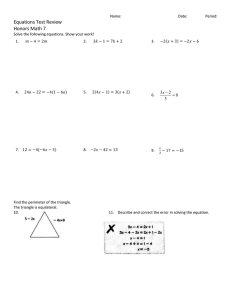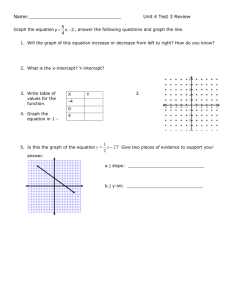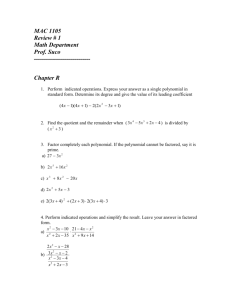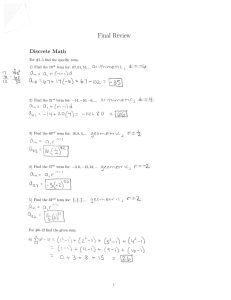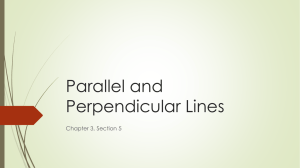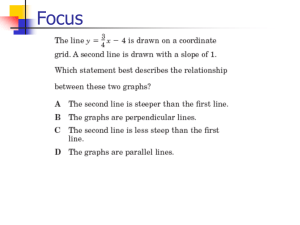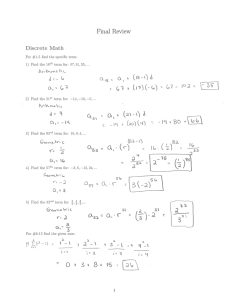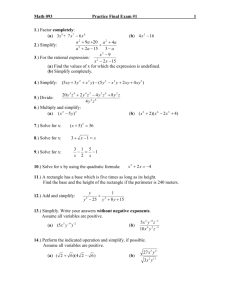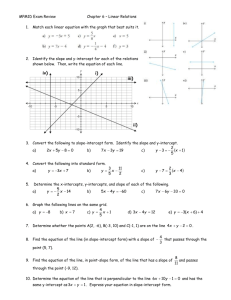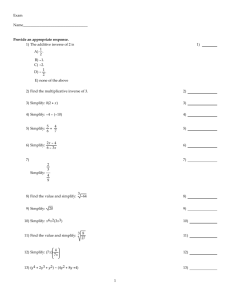COMPASSforMA108ReviewSpr09
advertisement
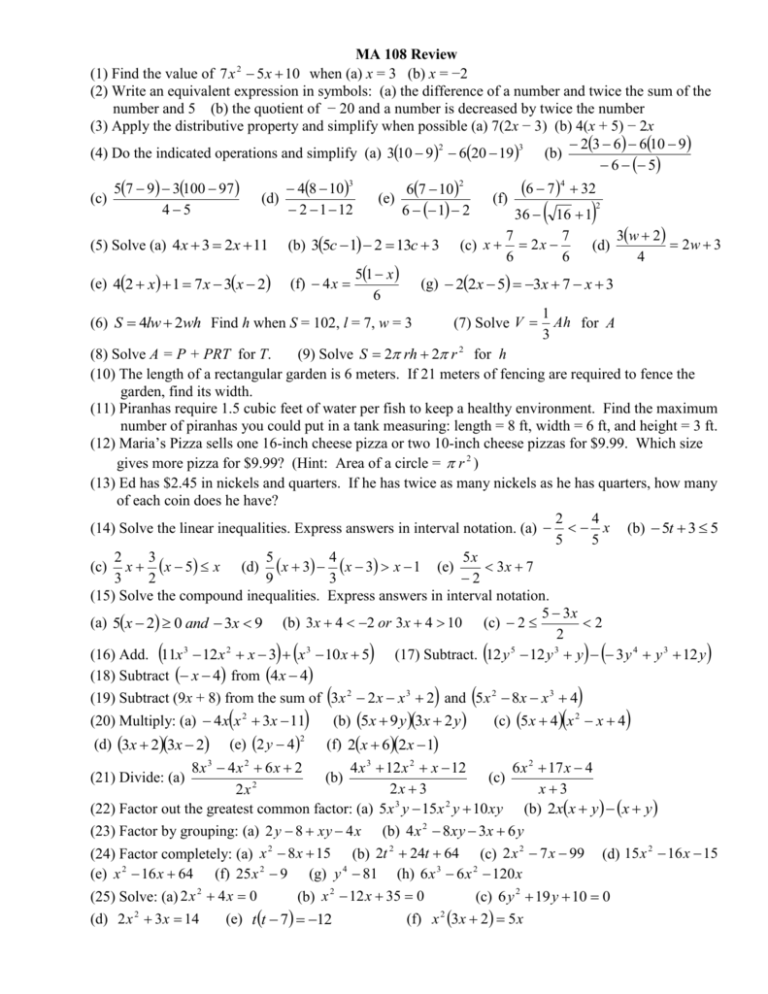
MA 108 Review
(1) Find the value of 7 x 5 x 10 when (a) x = 3 (b) x = −2
(2) Write an equivalent expression in symbols: (a) the difference of a number and twice the sum of the
number and 5 (b) the quotient of − 20 and a number is decreased by twice the number
(3) Apply the distributive property and simplify when possible (a) 7(2x − 3) (b) 4(x + 5) − 2x
23 6 610 9
2
3
(4) Do the indicated operations and simplify (a) 310 9 620 19
(b)
6 5
2
(c)
57 9 3100 97
45
48 10
2 1 12
3
(d)
67 10
6 1 2
2
(e)
(5) Solve (a) 4x 3 2x 11
(b) 35c 1 2 13c 3
(e) 42 x 1 7 x 3x 2
(f) 4 x
51 x
6
(f)
(c) x
6 7 4 32
36
16 1
2
7
7
2x
6
6
(d)
3w 2
2w 3
4
(g) 22x 5 3x 7 x 3
(7) Solve V
(6) S 4lw 2wh Find h when S = 102, l = 7, w = 3
1
Ah for A
3
(8) Solve A = P + PRT for T.
(9) Solve S 2 rh 2 r 2 for h
(10) The length of a rectangular garden is 6 meters. If 21 meters of fencing are required to fence the
garden, find its width.
(11) Piranhas require 1.5 cubic feet of water per fish to keep a healthy environment. Find the maximum
number of piranhas you could put in a tank measuring: length = 8 ft, width = 6 ft, and height = 3 ft.
(12) Maria’s Pizza sells one 16-inch cheese pizza or two 10-inch cheese pizzas for $9.99. Which size
gives more pizza for $9.99? (Hint: Area of a circle = r 2 )
(13) Ed has $2.45 in nickels and quarters. If he has twice as many nickels as he has quarters, how many
of each coin does he have?
2
4
(14) Solve the linear inequalities. Express answers in interval notation. (a) x (b) 5t 3 5
5
5
2
3
5
4
5x
3x 7
(c) x x 5 x (d) x 3 x 3 x 1 (e)
3
2
9
3
2
(15) Solve the compound inequalities. Express answers in interval notation.
5 3x
2
(a) 5x 2 0 and 3x 9 (b) 3x 4 2 or 3x 4 10 (c) 2
2
(16) Add. 11x 3 12 x 2 x 3 x 3 10 x 5
(17) Subtract. 12 y 5 12 y 3 y 3 y 4 y 3 12 y
(18) Subtract x 4 from 4x 4
(19) Subtract (9x + 8) from the sum of 3x 2 2 x x 3 2 and 5x 2 8x x 3 4
(20) Multiply: (a) 4 x x 2 3x 11
(b) 5x 9 y 3x 2 y
(c) 5 x 4 x 2 x 4
(d) 3x 23x 2
(e) 2 y 4
2
(f) 2x 62 x 1
8x 4 x 6 x 2
4 x 3 12 x 2 x 12
6 x 2 17 x 4
(b)
(c)
2x 3
x3
2x 2
3
2
(22) Factor out the greatest common factor: (a) 5 x y 15 x y 10 xy (b) 2xx y x y
(23) Factor by grouping: (a) 2 y 8 xy 4 x (b) 4 x 2 8 xy 3x 6 y
(24) Factor completely: (a) x 2 8 x 15 (b) 2t 2 24t 64 (c) 2 x 2 7 x 99 (d) 15 x 2 16 x 15
(e) x 2 16 x 64 (f) 25 x 2 9 (g) y 4 81 (h) 6 x 3 6 x 2 120 x
3
2
(21) Divide: (a)
(25) Solve: (a) 2 x 2 4 x 0
(b) x 2 12 x 35 0
(c) 6 y 2 19 y 10 0
(d) 2 x 2 3x 14
(e) t t 7 12
(f) x 2 3x 2 5 x
2x
1
x 1 x 1
2p
2 p
6
2
(e)
p3
p
p 3p
(26) Add or subtract the rational expressions. Simplify answers. (a)
(c)
4y
5
2
2
y 1 y 2y 1
(d)
t
5t
4
2
t2
t
t 2t
2
(b)
y
8
y2 2 y
1 1 1
1
1
x2
z
1
2z 5
2
(b)
(c)
x 6 4
x x3 x3
z 1 z 2 z 3z 2
5
2
x 1
(e)
x2 x3 x3
(27) Solve the rational equations. (a)
(d)
3
1
10
2
x 1 1 x x 1
3
x2
(c) x = 4
(d) y = 3
4
(29) For the linear equations in #28, find the slope, x-intercept and the y-intercept.
(30) Determine if the lines are parallel, perpendicular or neither. (a) x + y = 2, y = x + 5
1
y x
(b) 3x + 6y = 1,
(c) 2x + 3y = 9,
3x – 2y = 5
(d) y = 5,
x=3
2
(31) Find the slope of the line that goes through the points (4, -2), (-3, -7)
(32) Find the equation for the line that goes through the point (1, -2) and has slope -3.
2
(33) Find the equation for the line that goes through the point (-3, 6) and has slope .
3
(34) Find the equation for the line that goes through the points (3, -1) and (1, -4)
(35) Find the equation for the line that is parallel to 2x + 4y = 5, passing through (1, 2)
(36) Find the equation for the line that is perpendicular to 6x – 3y = 18, passing through (4, -3).
(37) Find the equation for the line shown on the graph.
(b) y
(28) Graph the lines: (a) 2x + 3y = 6
(38)Determine which of the following are functions and explain your answer.
a) {(1, 2), (3, 6), (5, -1), (2, 3)}
(b) {(1, 2), (3, 6), (5, -1), (3, 7)}
(c)
(d)
(d)
(39) Answer the following questions about the given graph.
a) What is the domain? (b) Range (c) f (-2) (d) f (3)
(e) y-intercept
(f) x-intercept
(40) f ( x)
x2 3
Find: (a) the domain of the function (b) f (2) (c) f ( -2)
3x 2
(41) Find each root. (a) 4x 2 (b) 3 8a 3 (c) x 2 10 x 25 (d) 5 (2) 5
(42) Find each root. Assume that all variables represent positive real numbers.
8
1 8
(a) 144
(b) 3
(c) 4
(d) 36 x 6 y 12
x
27
81
o
(43) Simplify. Assume all variables represent positive real numbers.
5x
(a) 175a 2 b 3
(b) 3 16 x 12 y 4
(c) 4
(d)
16 z 4
(f)
8
xy
(g)
1
(h)
2 1
2
(e)
50
2
9
x y
(44) Multiply. Simplify the answers. Assume all variables represent positive numbers
3
x y
(i)
5 3
3
52
(b) x( x 3) x 3 ( x 3)
(c) 3 2 4 6 2 7
(d) 2 3 1 3 1
(e)
(45) Simplify and combine like radicals. All variables represent positive numbers.
(a) 4 2 x 6 2 x
(b) 2 8
(c) 98 50 72
(46) Solve. (a) 5 x 6 2
(b) 6 x 1 2 7
(c) y 2 4 y
(a)
3
52
3 3 18
2
3
17
(47)Solve using the principle of square roots. (a) 4x = 20 (b) y
(c) x2 – 10x + 25 = 64
4
16
2
2
(48) Solve by completing the square. (a) x + 6x + 4 = 0
(b) 2 = x – 5x
2
2
(c) 9 – 3r = r
(d) x + 10x – 7 = 0
(e) x2 – 2x – 17 = 0
2
(49)Solve the following by using the quadratic formula. (a) x2 – 3x + 2 = 0
(b) 6x2 – x – 1 = 0
x2 x 1
(c) 5x2 + 5x + 1 = 0
(d)
(e) x 2 10 x 18
(f) x2 – 2x – 6 = 0
8 4 2
(50)Solve each of the following equations that are reducible to quadratic. (a) x 4 17 x 2 16 0
2
1
(b) 2(2 x 1) 2 7(2 x 1) 6 0 (c) 2 x 2 x 1 1 0 (d) a 3 2a 3 3 0 (e) 3x 4 x 1 0
(51) Mark’s workout consists of jogging for 3 miles, and then riding his bike for 5 miles at a speed 4
miles per hour faster than he jogs. If his total workout time is 1 hour, find his jogging speed and his
biking speed.
(52)Together, Noodles and Freckles eat a 50-lb bag of dog food in 30 days. Noodles by himself eats a
50-lb bag in 2 weeks less time that Freckles does by himself. How many days to the nearest whole
day would a 50-lb bag of dog food last Freckles?
(53) A whole number increased by its square is two more than twice itself. Find the number.
(54) f ( x) ( x 2) 2 1 find: (a)vertex (b) axis of symmetry (c) x-intercepts (d) y-intercept (e) graph
(55) The graph of f ( x) x 2 8 x 11 is just like the graph of f ( x) x 2 except it is shifted
______units to the ______________ and __________ units____________.
(right or left)
(up or down)
Solutions
20
2 x (3)(a) 14x − 21 (b) 2x + 20 (4)(a) −3 (b) 0
(1)(a) 58 (b) 48 (2)(a) x 2x 5 (b)
x
32
54
7
6
5
(c) 19 (d)
(e)
(f) 3 (5)(a) 4 (b) 4 (c)
(d)
(e) no solution (f)
15
3
5
5
19
2
S 2 r
3V
A P
(g) all real numbers (6) 3 (7) A
(8) T
(9) h
(10) 4.5 m
(11) 96
h
PR
2 r
1
45
2
(12) one 16-inch pizza (13) 7 quarters, 14 nickels (14)(a) , (b) , (c) ,
2
7
5
15
14
1
(d) , (e) , (15)(a) 2, (b) , 2 2, (c) , 3
4
11
3
3
2
5
4
3
(16) 12 x 12 x 9 x 2 (17) 12 y 3 y 13 y 11y (18) 5x (19) 2 x 3 8 x 2 19 x 2
(20)(a) 4 x 3 12 x 2 44 x (b) 15 x 2 37 xy 18 y 2 (c) 5 x 3 x 2 16 x 16 (d) 9 x 2 4
(22)(a) 5 xy x 2 3x 2
(b) x y 2x 1
(24)(a) x 5x 3 (b) 2t 8t 4
3 1
x x2
(23)(a) y 42 x
(21)(a) 4 x 2
(f) 4 x 2 22 x 12
(e) 4 y 2 16 y 16
(c) 2 x 11x 9
(b) 2 x 2 3 x 4 (c) 6 x 1
(b) x 2 y 4 x 3
(d) 5x 33x 5
(e) x 8
1
x3
2
(f) 5x 35x 3 (g) y 2 9 y 3 y 3 (h) 6 xx 5x 4 (25)(a) 0, −2
7
(d) , 2
2
3p 1
p3
(28) (a)
(e)
5
1
(f) 0, , 1 (26)(a)
3
x 1
(e) 3, 4
(27)(a) 12
(b) 1
(c) 3 (d) 3
(b)
(b)
y 8
y2
2
5
(b) 5, 7 (c) ,
3
2
2
4y y 5
3
(c)
(d)
2
t
y 1 y 1
(e) no solution
(c)
(d)
3
8
y-int: (0, 2) x-int: , 0
4
3
(d) slope = 0 y-int: (0, -3) x-int: none
5
(30)(a) Perpendicular (b) neither (c) perpendicular (d) perpendicular (31)
(32) y = -3x + 1
7
2
3
11
1
5
1
2
(33) y x 4
(34) y x
(35) y x
(36) y x 1 (37) y x 1
3
2
2
2
2
2
3
(38) (a) is a function (b) is not a function since 3 “goes to” 6 and to 7 (c) is a function (d) is not a
function by the vertical line test.
(39)(a) (∞, 1) U [3, ∞) (b) (∞, 3) U [4, ∞) (c) 1 (d) 4
1
1
2
(e) (0, 2) (f) (-1.5, 0) (40) (a) x | x , x (b)
(c)
(41)(a) 2| x | (b) 2a
8
4
3
2
1
(c) | x + 5 | (d) 2
(42) (a) does not exist in the real numbers (b)
(c) x 2 (d) 6 x3 y6
3
3
3
4
2 2 xy
5x
6
6
(43)(a) 5ab 7b
(b) 2 x 4 y 3 2 y
(c)
(d)
(e)
(f)
(g) 2 1
2z
10
3
xy
2
y-int: (0, 2) x-int: (3, 0)
3
(c) slope is undefined, y-int: none, x-int: (4, 0)
(29)(a) slope =
(h)
10 3 2
4
(i)
(b) slope =
x 2 xy y
(44)(a) 3 3 2
x y
(b) 2
(45) (a) 10 2 x
(b)x2(x + 3)
(c) 4 2
(c) 24 3 6 14
(46) (a) 2
(d) 5 3 (e) 1
(b) 4
(c) 2
5 17
33 5
(c)
2
2
1 1
5 5
(d) − 5 4 2 (e) 1 3 2 (49)a) 2, 1 (b) ,
(c)
(d) 1 5 (e) 5 7
3 2
10
1
1 1
(f) 1 7 (50)(a) 4, 4, 1, 1
(b) ,
(c) 2, 1
(d) 1, 27
(e) , 1
2 4
9
(51) Jogging: 6mph, biking: 10 mph
(52) 68 days
(53) 2
(54)(a) (−2, −1)
(b) x = −2
(47)(a) 5
(b)
(c) (−1, 0), (−3, 0)
3 17
4
(d) (0, 3)
(c) 13, 3
(e)
(48)(a) 3 5
(b)
(55) 4 units right, 27 units down
